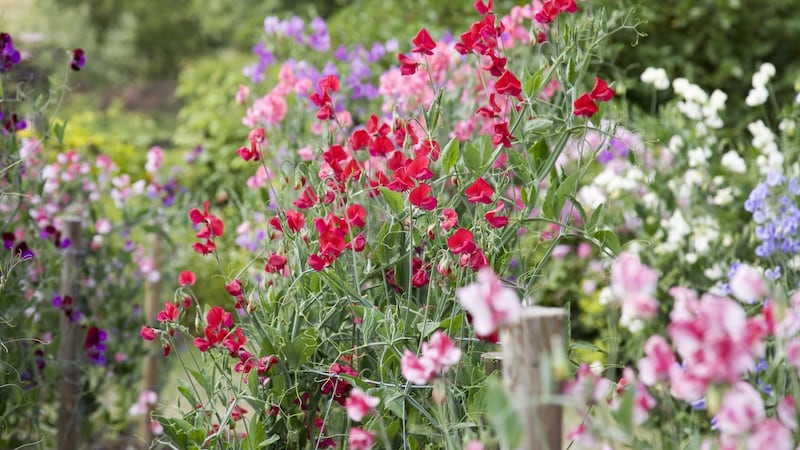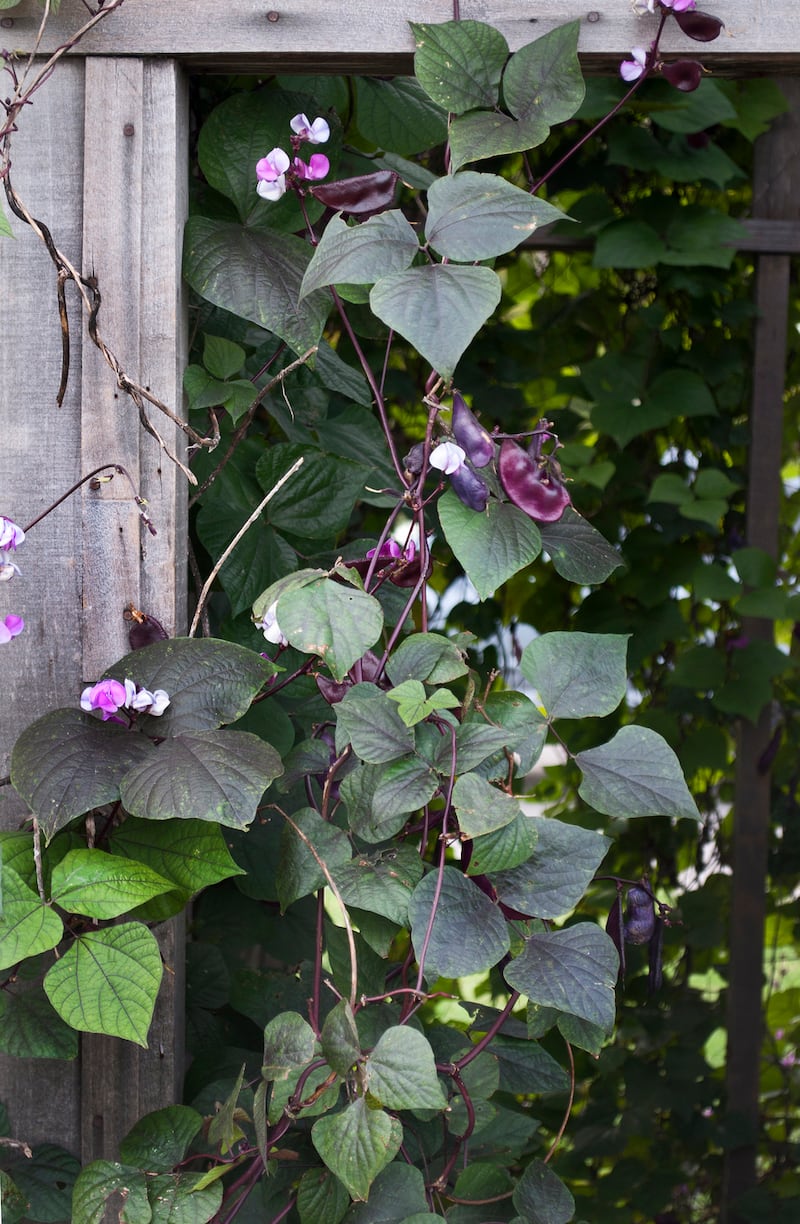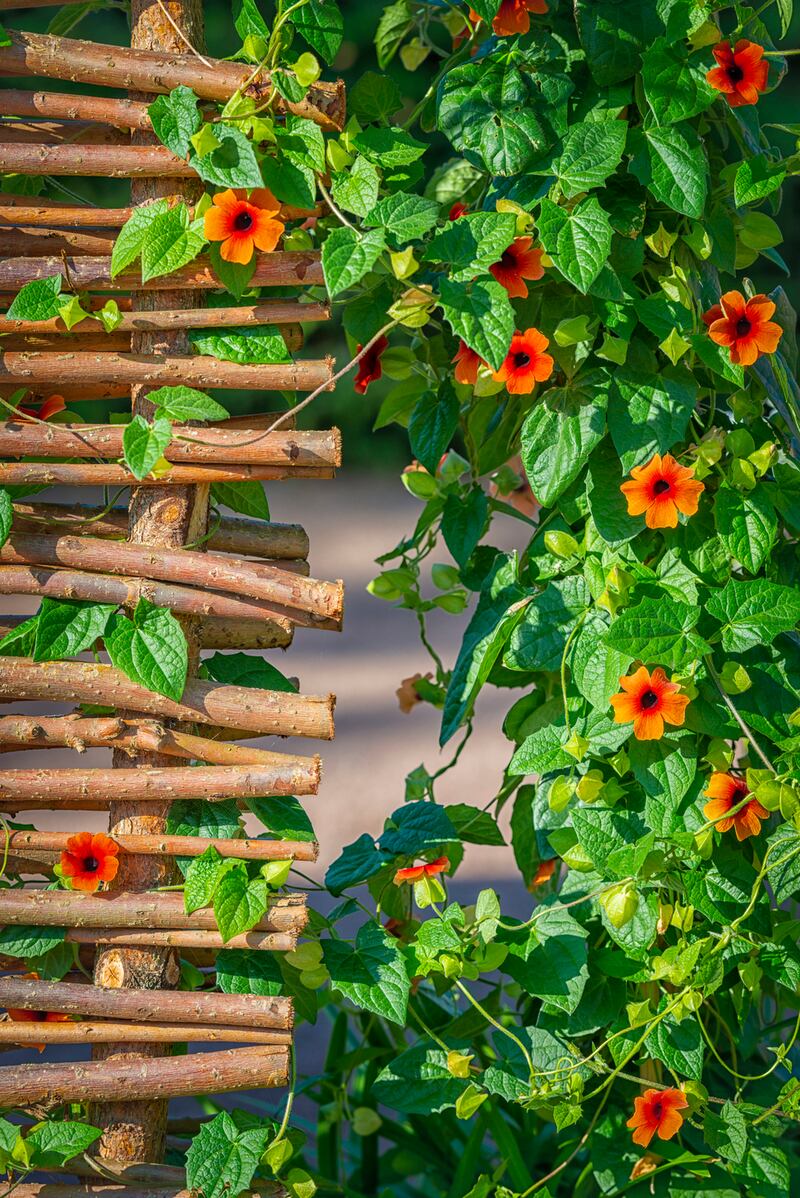In much the same way I enjoy the simple, quick-fix, rush of carbs-to-the-head pleasure of an occasional takeaway, I also appreciate the charms of what you might call fast gardening.
An example is annual climbers, a rapid-growing, highly ornamental, easy-to-cultivate group of plants if ever there was one. Sweet peas are the best known members of this merry band with their Jack-in-the-Beanstalk ability to scramble up a sunny wall, fence, trellis, arbour, pergola or willow wigwam so quickly that within a few short months it’s covered in tall, dense swathes of their intensely scented, colourful blooms.
Hardy annuals, the young plants will even take a surprising degree of frost – as low as -5 degrees – and are best planted into their permanent positions in the garden at this time of year so that they have plenty of time to get their roots deeply in the ground. As greedy feeders, they need a fertile, moisture-retentive but free-draining soil enriched with plenty of well-rotted manure and/or homemade garden compost.
Ideally their hard, round, peppercorn-sized seeds should be sown in late autumn/late winter but can still be sown this month to give you plants that will flower by summertime. Just bear in mind that sweet pea doesn’t need – and in fact doesn’t like – heat to successfully germinate. So for best results pre-chit the seed by putting it in a small, sealed container filled with damp kitchen paper and then placing this in a cool, bright spot.

Once you spot signs of germination, very gently transplant each sprouting seed 10-12mm deep into a smallish pot/root trainer filled with a good quality multi-purpose compost, making sure to position them so that their young growing shoots are pointing upwards and their baby root systems are pointing downwards (no plant wants to grow upside down). Water lightly before placing these pots somewhere bright, cool and rodent/slug-proof to grow on.
With spring-sown sweet pea, it’s also a good idea to pinch out the growing tips of the young plants (do this when they’ve reached a height of 10-15cm) to encourage strong, bushy growth.
Sweet pea aside, there's a host of other lesser-known but very decorative, fast-growing species of climbing plants – the vast majority of them tender or half-hardy species that hail from hotter, sunnier parts of the world – that can be grown outdoors in a sunny, sheltered spot in a normal Irish summer. Many will also flourish in a glasshouse, polytunnel, conservatory or large, bright hallway. Examples include different species of the morning glory vine (Ipomaea), a vast genus of plants native to America, Africa, Asia and Australia with short-lived but spectacularly decorative, trumpet-shaped flowers.
Many different varieties are available to buy as seed, including the enduringly popular Ipomaea purpurea Grandpa Ott, prized for its dark violet-blue flowers that appear in abundance throughout summer/early autumn, and its vigorous, floriferous growth habit. Other garden-worthy varieties include Ipomaea tricolour heavenly blue (large, delphinium-blue flowers); Ipomaea purpurea Venice pink (candy-pink and white striped flowers); Ipomaea multifida (long, vermilion-coloured flowers with a white throat); and Ipomaea lobata, a climbing species utterly unlike its cousins with ferny foliage and spikes of ember-coloured flowers.
All will grow happily in a large pot or tub as long as they’re given a free-draining compost plus some sturdy form of support for their twining stems and are kept regularly deadheaded to encourage the plentiful production of new blooms.

Examples of other fast-growing summer/early autumn-flowering climbers suitable for growing in a large pot or tub or up against a wall/pergola/arbour in a sheltered sunny position outdoors include the Chilean glory vine (Eccremocarpus scaber ), a very tall species which bears its spikes of colourful scarlet, orange and yellow flowers all summer long; the purple-leaved hyacinth bean (Dolichos lablab) whose long, deeply scented, wine-coloured flower racemes are also good for cutting; the purple bell vine (Rhodochiton atrosanguineum) , a native of Mexico with pretty, heart-shaped leaves and clusters of dusty-purple, bell-shaped flowers; black-eyed Susan (Thunbergia alata), a very easy-to-grow climber with starry, dark-eye flowers in shades of peachy-yellow, red, apricot and cream; and some very ornamental climbing species of nasturtium including Tropaeolum peregrinum, a hardy annual native to Peru that produces its brilliant-yellow flowers in profusion throughout the summer and early autumn.
I like to think of these plants as the tropical butterflies of the summer flower garden; ephemeral but strikingly beautiful, they will grow like rockets and bloom their socks off for a few brief but glorious months before finally succumbing to the first harsh frosts of autumn. Although most are technically perennials, for the purposes of propagation they should be treated as short-lived annuals: sow the seed indoors in spring on a sunny windowsill or under cover of a frost-free glasshouse, polytunnel, conservatory or bright porch before moving them to their final growing positions in late spring/early summer.

An electric propagator to provide some bottom heat will speed up the process of germination, but it’s not essential. Just make sure to use a good quality seed-compost and to keep it very slightly damp to the touch but never sodden.
To encourage good germination, I like to sow into 2l pots, which I cover with upturned clear plastic freezer bags sealed with an elastic band. I then bottom-water these pots by placing them up to their waists in a basin of tepid water for a couple of hours before placing them somewhere warm and bright.
Once you spot the first obvious signs of germination, it’s important to quickly start the process of gradually accustoming the baby seedlings to cooler temperatures and lower humidity by partially and then fully removing the plastic bags. When the baby seedlings have developed their first true leaves, it’s time to prick them out by gently lifting them out of their pots by their leaves (use a pencil or pen to gently free their baby root systems from the compost without damaging them) and then transplanting them into individual pots or cell trays before watering them.
These young plants should then be placed in a very bright, frost-free spot and grown on under cover for transplanting into their final growing positions in late spring. By high summer, they’ll be filling your garden with exotically colourful blooms.
(Seed of the above is available to order from good Irish garden centres as well as online suppliers such as seedaholic.com and mrmiddleton.com.)

This Week in the Garden
Plant fast-cropping, early varieties of potatoes, seed of which is available from all good Irish garden centres as well as from online specialist suppliers such as quickcrop.ie, fruithillfarm.com and mrmiddleton.com, planting them at a spacing of 25cm between tubers and 50cm between rows, and to a depth of 15cm. Potatoes need a fertile, weed-free moisture-retentive but free-draining soil enriched with plenty of well-rotted manure or garden compost and a sunny, open spot away from the shade of overhanging trees or hedges. Where space is tight, you can also grow them in large buckets/tubs or even in strong black plastic bags.
This is a great time of the year to plant onions and shallots as sets (baby bulbs). For best results, give them a weed-free, free-draining soil in a sunny, sheltered spot in the allotment or garden, making sure to use healthy, firm sets to avoid accidentally introducing plant diseases. To boost soil fertility, rake in a small amount of well-rotted manure or garden compost and add a sprinkle of potash-rich wood ash or powdered seaweed. As both of these members of the allium family struggle to establish strong root systems in loose soil, it’s important to gently firm the ground down with a wooden board before planting.
Recommended varieties suitable for spring planting include sturon, boga, Centurion (onions) and red sun and golden gourmet (shallots).



















